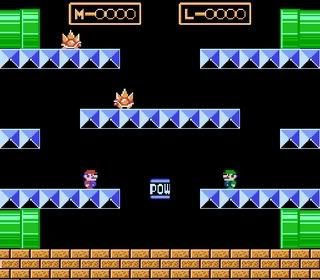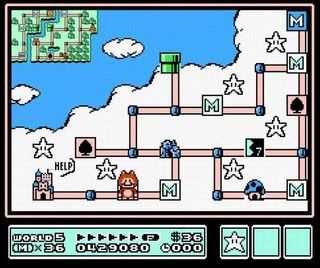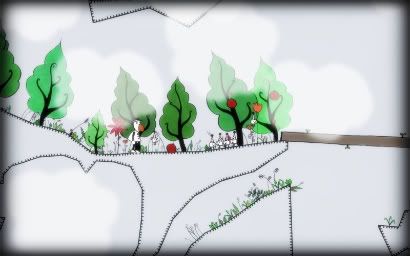
There is an outspoken assumption that seems to be shared by many "hardcore" gamers (read: people who have been playing video games for more than twenty years), and it goes something like this: you don't mess with Super Mario Bros. 3, King of 2-D Platformers. Admittedly, it is "It" that introduced such concepts as the "world map" and "hidden secrets" to a genre not especially known for depth and latitude, and perfected platform physics to a stupendous degree of immediacy. But still, that kind of information is hard to process for someone who has grown up on Super Mario World. As expansive and ambitious as its predecessor may have been, the gorgeous and sprawling SNES game seemed to have it all at the time, whether or not we may still be able to enjoy it to its fullest (as Chris Lepine briefly discusses here). For me, the war between the epitomes of Mario games is one that never ended, and one that I needed to tackle head-on in this later age.
I had been meaning to dive back into Super Mario Bros. 3 for some time, but it is Tim Rogers' dense and rambling, wildly entertaining review of the game that finally convinced me to give it a shot. And yet, for all its passion, quirky insights and odd fixation with terms such as "friction" and "common sense", the review fails to explore one aspect of SMB3 that for some reason seems to be neglected by enthusiasts everywhere ; namely, the multiplayer. "Why is it", I asked myself in puzzlement, "that we tend to dismiss the adventures of the Super Mario Brothers as those of Mario alone?". Why is it, although there might be solid arguments to support that position, that we automatically associate every "canonical" Mario game with a single-player experience? And so it is with these questions in mind that I prudently approached SMB3 once again, with a couple of friends in tow. Little did I know that I would soon find myself in complete fascination with the game's subtleties.
In short, what I found is that, apart from its obvious achievements in level design and character handling, Super Mario Bros. 3 may well contain one of the most ambiguous multiplayer components of any video game to date. This "ambiguity" that I speak of is never explicitly stated and may have not even been intended, but it is present nonetheless, at every step of any game session. Consider these elements that enrich SMB3's gameplay, but that we have come to accept without much thought: the mushroom huts that contain helpful articles, the gates that crash once a mini-boss has been defeated, the pipes laden to zip throughout the map, and so on. Now, consider how these additions affect gameplay with another person ; without diving too much in the details, let's just say that they play a large part in the strange mix of competition and collaboration that naturally emerges from the game's design.
Plainly, the first thing that one might do at the outset of a two-player session of Super Mario Bros. 3 is pressing the B button to initiate a "battle" stage. The reasons for this are left to the players: do they duke it out as a way of determining who "deserves" to go first? Or simply as a way to warm up? There is little concrete motivation for doing this, but some might be tempted anyway. After that initial phase, the game informally takes the shape of a race to the first hut or slot machine, with more opportunities to engage into battle, and a certain incentive for the players to smartly manage what they do with their respective turns. Each is responsible for his or her own stock of lives, items, and level-end "cards", and a defeated player might benefit from a pipe or pathway unlocked by the other. And so, gradually, the innovative nature of Super Mario Bros. 3 might come into view ; while the addition of a world map may have proven compelling for a single adventurer of the time, its combination with a pair of fairly competent players turns into an entirely new form of board game, one that is tightly dependent on the electronic nature of video gaming, and devoid of strict rules concerning the unfolding of the session.
I had been meaning to dive back into Super Mario Bros. 3 for some time, but it is Tim Rogers' dense and rambling, wildly entertaining review of the game that finally convinced me to give it a shot. And yet, for all its passion, quirky insights and odd fixation with terms such as "friction" and "common sense", the review fails to explore one aspect of SMB3 that for some reason seems to be neglected by enthusiasts everywhere ; namely, the multiplayer. "Why is it", I asked myself in puzzlement, "that we tend to dismiss the adventures of the Super Mario Brothers as those of Mario alone?". Why is it, although there might be solid arguments to support that position, that we automatically associate every "canonical" Mario game with a single-player experience? And so it is with these questions in mind that I prudently approached SMB3 once again, with a couple of friends in tow. Little did I know that I would soon find myself in complete fascination with the game's subtleties.
In short, what I found is that, apart from its obvious achievements in level design and character handling, Super Mario Bros. 3 may well contain one of the most ambiguous multiplayer components of any video game to date. This "ambiguity" that I speak of is never explicitly stated and may have not even been intended, but it is present nonetheless, at every step of any game session. Consider these elements that enrich SMB3's gameplay, but that we have come to accept without much thought: the mushroom huts that contain helpful articles, the gates that crash once a mini-boss has been defeated, the pipes laden to zip throughout the map, and so on. Now, consider how these additions affect gameplay with another person ; without diving too much in the details, let's just say that they play a large part in the strange mix of competition and collaboration that naturally emerges from the game's design.
Plainly, the first thing that one might do at the outset of a two-player session of Super Mario Bros. 3 is pressing the B button to initiate a "battle" stage. The reasons for this are left to the players: do they duke it out as a way of determining who "deserves" to go first? Or simply as a way to warm up? There is little concrete motivation for doing this, but some might be tempted anyway. After that initial phase, the game informally takes the shape of a race to the first hut or slot machine, with more opportunities to engage into battle, and a certain incentive for the players to smartly manage what they do with their respective turns. Each is responsible for his or her own stock of lives, items, and level-end "cards", and a defeated player might benefit from a pipe or pathway unlocked by the other. And so, gradually, the innovative nature of Super Mario Bros. 3 might come into view ; while the addition of a world map may have proven compelling for a single adventurer of the time, its combination with a pair of fairly competent players turns into an entirely new form of board game, one that is tightly dependent on the electronic nature of video gaming, and devoid of strict rules concerning the unfolding of the session.

While I may not have made my point entirely clear, compare this mode with that of the original Super Mario Bros., or even of the more sophisticated Super Mario World: two players, alternating turns, working towards the end of the current level. While the latter may at least have the players share a consistent map (and thus general progression through the world), the fact is that these games are simply not set up to allow any interesting interplay to occur between the participants. Given the lack of reason to mind their individual avatar, a pair of players is much more likely to fire up a solo game and to pass the controller, whereas the rarefied "special spots" on Super Mario Bros. 3's world map act as anything but idle distractions ; they are milestones to look forward to, to anticipate and orient one's play in the immediate, and represent much more than a way of accumulating extra lives and puffing up one's arsenal (as they are in the flawed, conflicted New Super Mario Bros. for the DS). Branching paths call forth a choice, usually between levels of differing challenge, and the mobile "Hammer Bros." constitute the dynamic element that keeps the playfield lively. In other words, every turn in Super Mario Bros. 3 represents a gamble towards tangible and fluctuating stakes, while every other Mario consists of a steady climb, with only minor bumps along the way.
As the difficulty ramps up (and it does start to ramp up really fast), the competitive mindset of reaching the next milestone or simply getting more playtime than one's partner may begin to fade in the background. Naturally, through increased danger and level complexity, the incentive of getting through the present world becomes of prime importance, and Super Mario Bros. 3 delicately turns into the kind of collaborative experience that its brethren proposed without applying much thought to it. The elements of interplay, however, are never exactly suppressed, and logically meld themselves into the structure of the game in ways that can be taken advantage of. From this point on, the process of surviving the ordeals of ever-greater magnitude can become rather involved: one player might work through a difficult portion to open a bonus stage for the other to refill his stock of lives, while his partner may try to obtain an item equally helpful to breezy progression. At all times, it is important that one player doesn't go and clear every stage, because his expiration would entail the resetting of said levels. And still, unlike games such as Donkey Kong Country (which effortlessly and quite brilliantly integrated collaboration in the core of its design), this strange, unspoken sort of co-op gameplay manages to work despite the avatars almost never sharing the action. At the end of the day, every player remains responsible for his or her performance, and in this regard the game may not appear so different from other Mario installments ; but in the sense that every mistake is an opportunity for learning the nuances of the game and to flex some oblique teamwork skills, to share the experience makes it that much more rewarding.
For motives undoubtedly pertaining to their large scale and completionist nature ("kleptomaniac", as Tim Rogers would put it), the Mario games have been traditionnally associated with single-player enjoyment. The excellent Yoshi's Island would be a solitary affair through and through, as would Super Mario 64 and the rest of its 3-D progeny. They have been turned explicitly into a "virtual board game" by way of the abysmal Mario Party series ; one that nearly reduces playing to being a spectator, occasionally stirs the pot with afterthoughts disguised as "mini-games", and fills the blanks with cringe-inducing bells and whistles. And yet, even while granting multiple users the occasion to "share the screen" at several points, it doesn't really seem to allow them to "share the game" in any way that doesn't imply greed and otherwise selfish dispositions. Super Mario Bros. 3, on the other hand, subtly walks the line between being an individual and a shared experience, with shifting, elliptical goals that don't interfere with the main act of clearing the levels. As such, by assigning a series of general destinations without imposing on the proceedings, it frees the players to experiment with the game, together, in whatever crazy manner they want, and fully embraces the playful "wiggle room" that the best video games allow. Surely that must deserve a little approving nudge, right?
As the difficulty ramps up (and it does start to ramp up really fast), the competitive mindset of reaching the next milestone or simply getting more playtime than one's partner may begin to fade in the background. Naturally, through increased danger and level complexity, the incentive of getting through the present world becomes of prime importance, and Super Mario Bros. 3 delicately turns into the kind of collaborative experience that its brethren proposed without applying much thought to it. The elements of interplay, however, are never exactly suppressed, and logically meld themselves into the structure of the game in ways that can be taken advantage of. From this point on, the process of surviving the ordeals of ever-greater magnitude can become rather involved: one player might work through a difficult portion to open a bonus stage for the other to refill his stock of lives, while his partner may try to obtain an item equally helpful to breezy progression. At all times, it is important that one player doesn't go and clear every stage, because his expiration would entail the resetting of said levels. And still, unlike games such as Donkey Kong Country (which effortlessly and quite brilliantly integrated collaboration in the core of its design), this strange, unspoken sort of co-op gameplay manages to work despite the avatars almost never sharing the action. At the end of the day, every player remains responsible for his or her performance, and in this regard the game may not appear so different from other Mario installments ; but in the sense that every mistake is an opportunity for learning the nuances of the game and to flex some oblique teamwork skills, to share the experience makes it that much more rewarding.
For motives undoubtedly pertaining to their large scale and completionist nature ("kleptomaniac", as Tim Rogers would put it), the Mario games have been traditionnally associated with single-player enjoyment. The excellent Yoshi's Island would be a solitary affair through and through, as would Super Mario 64 and the rest of its 3-D progeny. They have been turned explicitly into a "virtual board game" by way of the abysmal Mario Party series ; one that nearly reduces playing to being a spectator, occasionally stirs the pot with afterthoughts disguised as "mini-games", and fills the blanks with cringe-inducing bells and whistles. And yet, even while granting multiple users the occasion to "share the screen" at several points, it doesn't really seem to allow them to "share the game" in any way that doesn't imply greed and otherwise selfish dispositions. Super Mario Bros. 3, on the other hand, subtly walks the line between being an individual and a shared experience, with shifting, elliptical goals that don't interfere with the main act of clearing the levels. As such, by assigning a series of general destinations without imposing on the proceedings, it frees the players to experiment with the game, together, in whatever crazy manner they want, and fully embraces the playful "wiggle room" that the best video games allow. Surely that must deserve a little approving nudge, right?
